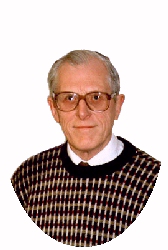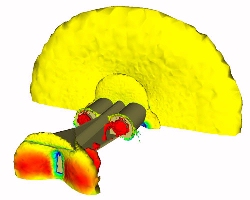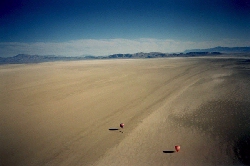
This brief note discusses the noise and shock waves from high speed vehicles, with particular reference to Thrust SSC. It seems unlikely that noise from Thrust SSC will cause serious problems in Black Rock Desert. However it is proposed to monitor the noise during runs, thus eliminating even the smallest risk of causing damage or inconvenience.
The principal sources of noise generated by Thrust SSC will be from the Spey engines and from transonic shockwaves. The influence of these two sources of noise on viewing public is considered in this note. It has been assumed that the viewing public will be not less than one quarter of a mile to one side of the track.

We all experience shock waves during a thunder storm. A nearby lightning strike will produce a shockwave that is much more powerful than any that will be experienced by observers of a supersonic car. A clap of thunder also disturbs us more because it is sudden and unexpected, and because of our apprehension that we may be the next target for the lightning.
We voluntarily subject ourselves to shockwaves for pleasure when we watch a fireworks display. Another example of shockwaves being used as 'entertainment' was during the 1950's, when pilots at air displays would fly low over the spectators (or even straight at them) at sonic speeds. This was a great crowd-puller for several years, and I have clear recollections of these displays at Farnborough. Such manoeuvres were banned, not because of noise damage, but because of some fatal crashes.
If shock waves can be fun and do not harm us, why do they arouse antipathy? Well it is not so pleasant if you do not wish to be entertained, if you are trying to work (or sleep) and you are repeatedly being disturbed by bangs. Worse still, some careless pilots of high speed aircraft have caused substantial damage and anguish by low level runs over populated areas. Such damage has on occasions been amplified by chance 'focusing' effects caused by local terrain, meteorological conditions or by aircraft manoeuvres. Not surprisingly such incidents have caused a suspicion and resentment of shockwaves, and although I do not believe there will be damage or injury caused by Thrust SSC, I accept that there is a case to answer.
Many factors combine to minimise the influence of the transonic shock from Thrust SSC:

The bow-shock and the rear-shock will be separated by only 0.04 seconds, so will no doubt be heard as a single bang. Distortion and selective high-frequency absorption by the desert surface will degrade the noise from a sharp 'crack', and it will perceived more as a dull 'thud'.
It is difficult to predict precisely the strength of this thud at a lateral separation of ¼ mile, but I do not anticipate that it will exceed 13Odb.
Many factors influence the noise tolerance of the human ear to loud noise, such as duration and frequency. For this reason there is little agreement on what sound levels are comfortable, what levels are painful, and what levels cause damage to hearing. The following table is typical of figures quoted in the research literature illustrating the influence of noise duration on typical tolerance levels for broad band noise.
| 145db | possible damage to hearing by shockwave |
| 140db | pain threshold for shockwave |
| 130db | tolerence threshold for 10 seconds |
| 110db | tolerence threshold for one hour |
| 80 to 85db | maximum daily working level |
Thus, the estimated intensity of the Thrust SSC shockwave of is 10db (ie. a factor of 10) less than the pain threshold, and a factor of 30 less than the aural damage threshold. As the high frequencies will have been selectively reduced, the above figures may well be pessimistic.
Many studies have been conducted of jet noise near airport runways. From these I would predict that the noise experienced at the public enclosure one quarter mile from the track will peak at around 100db to 110db for a few seconds. This really should not inconvenience anyone. This assumes both engines on full reheat.
Although I am confident that noise will not be a serious problem for Thrust SSC, it makes sense to monitor sound levels, if only to allay possible fears of people nearby. Thus I propose to record sound levels, starting with the subsonic runs. This will enable us to predict with greater precision the sound levels and shockwave pressures on the higher speed runs, permitting us to ascertain the minimum allowable distance from the track for a person without ear protection.
 |
 |
 |
||
| Sponsored by | This site best viewed with Microsoft Internet Explorer 3 | |||